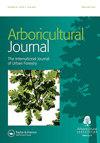Understanding urban forest functions and placing values on urban trees
Q3 Agricultural and Biological Sciences
引用次数: 0
Abstract
In this first issue for 2020, we have two main papers plus some issues-based correspondence and a book review. Maitra and Jyethi (2020) address the highly topical issue of the possible roles of urban trees in mitigating the effects on human health of the increasing levels of particulate matter (PM) in the atmospheres in megacities. In recent years, this has become a very serious concern of health practitioners and planners because of the implications of human exposure and deterioration of environmental quality. In India, Delhi is a city notorious for its especially high levels of particulate pollution. The Maitra and Jyethi research considers seasonal differences in PM removal from the atmosphere by the urban forest cover and provides a quantified assessment for Delhi. They studied particulate matter data from forty stations across Delhi and measured leaf area index (LAI) derived from remotely-sensed satellite images. Particulate matter removed during the wet summer period was lower than in the dry wintertime in a particular year. The results highlight the potential of forest cover in Delhi in particulate matter removal. The authors suggest the need for the careful selection of trees in relevant urban afforestation programmes. Price (2020) presents a timely review of the CAVAT (capital asset value for amenity trees) system for amenity tree valuation. This paper follows from that of Doick et al. (2018) to address issues at the very core of the arboricultural industry and of urban forest planning and evaluation. How do we as professionals and indeed, as a society, place values on urban trees? In particular, with competing demands for urban spaces, and matters of safety and maintenance, what mechanisms do we apply to better inform planning decisions? Then, if urban trees, particularly street-trees for example, are to be removed, what is the cost or the loss of value? If we take a system for the assessment of the amenity value of a particular tree, then how does this inform the mechanism for replacement or compensation if the tree is removed? Ideas and approaches to these paradigms were of course pioneered by the late Rodney Helliwell (1967, 2008, 2018), and this is a debate with which he would have undoubtedly engaged. Alternative approaches such as the CTLA (Council of Tree and Landscape Appraisers) guidance were presented by Cullen (2007) and debated at the amenity trees conference in the year preceding that; and the present author also responded to the debate (Price, 2007). Taken in a context of increasing demand for robust methodologies to guide planning and for evaluations to set trees alongside other valued assets in societal processes, and the growing tendency to try to assess so-called “ecosystem services”, then I suspect this debate will run and run. There is a danger of course that in some areas of say nature conservation for example, lobbyists state that the resource is so precious and Arboricultural Journal 2020, VOL. 42, NO. 1, 1–2 https://doi.org/10.1080/03071375.2020.1750203了解城市森林的功能和城市树木的价值
在2020年的第一期中,我们有两篇主要论文,加上一些基于问题的通信和一篇书评。Maitra和Jyethi(2020)解决了城市树木在减轻特大城市大气中颗粒物(PM)水平上升对人类健康的影响方面可能发挥的作用这一备受关注的问题。近年来,由于人类接触和环境质量恶化的影响,这已成为卫生从业人员和规划人员非常严重关切的问题。在印度,德里是一个因颗粒物污染水平特别高而臭名昭著的城市。Maitra和Jyethi的研究考虑了城市森林覆盖对大气中PM去除的季节性差异,并为德里提供了量化评估。他们研究了来自德里40个站点的颗粒物数据,并测量了来自遥感卫星图像的叶面积指数(LAI)。特定年份夏季湿润期颗粒物去除量低于冬季干燥期。研究结果强调了德里森林覆盖在去除颗粒物方面的潜力。作者建议在有关的城市造林方案中需要仔细选择树木。Price(2020)及时回顾了用于美化树估值的CAVAT(美化树的资本资产价值)系统。本文遵循Doick等人(2018)的研究,以解决树木产业和城市森林规划与评估的核心问题。作为专业人士,甚至作为一个社会,我们如何给城市树木赋予价值?特别是,面对城市空间的竞争需求,以及安全和维护问题,我们应该采用什么样的机制来更好地为规划决策提供信息?那么,如果要移除城市树木,特别是街道树木,其成本或价值损失是多少?如果我们采用一种评估特定树木的美化价值的系统,那么,如果树木被移走,该如何通知替换或补偿机制?当然,这些范式的思想和方法是由已故的罗德尼·赫利韦尔(Rodney Helliwell, 1967、2008、2018)开创的,毫无疑问,他也会参与到这场辩论中来。Cullen(2007年)提出了CTLA(树木和景观评估师委员会)指南等替代方法,并在之前一年的美化树木会议上进行了讨论;本文作者也对这一争论做出了回应(Price, 2007)。考虑到越来越需要强有力的方法来指导规划,以及在社会进程中将树木与其他有价值的资产放在一起进行评估,以及试图评估所谓的“生态系统服务”的趋势日益增长,那么我怀疑这场辩论将会持续下去。当然,在自然保护的某些领域存在危险,例如,游说者声称资源是如此珍贵,树木学杂志2020,VOL. 42, NO。1,1 - 2 https://doi.org/10.1080/03071375.2020.1750203
本文章由计算机程序翻译,如有差异,请以英文原文为准。
求助全文
约1分钟内获得全文
求助全文
来源期刊

Arboricultural Journal
Agricultural and Biological Sciences-Agronomy and Crop Science
CiteScore
2.40
自引率
0.00%
发文量
28
期刊介绍:
The Arboricultural Journal is published and issued free to members* of the Arboricultural Association. It contains valuable technical, research and scientific information about all aspects of arboriculture.
 求助内容:
求助内容: 应助结果提醒方式:
应助结果提醒方式:


